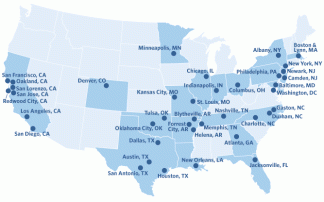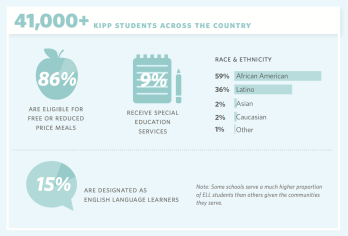Many people know about military schools, but few are aware of the lesser known alternative institutions known as KIPP schools. In the past, military schools have been what your parents threaten to send you to when you’ve been misbehaving. Part of their purpose served to straighten out troubled kids and provided a sense of structure in their life.

The first military schools were established in the 1800’s, most of which were higher education schools. Later on, military academy high schools started emerging and earned a reputation for being strict, harsh on punishment, and physically rigorous. Many parents, including those of one of our group member’s, would often use these schools as a threatening tool to scare their child into better behavior. However, while military secondary schools may be strict and harsh, nobody is there against their will. Today these institutions are more of a preparatory school for the military academies such as the United States Military Academy (West Point), United States Naval Academy (Annapolis), United States Air Force Academy, and many other military-based higher education schools. One of our group members can attest to the rigor of these schools, as they were accepted to the oldest military academy in the nation, West Point, and experienced their intensity in just the application process.
So now you may be asking “why is this relevant to KIPP?” After further research on the structure and demands of KIPP schools, we started to see some correlations between the two. So first let’s take a look at where and how KIPP schools originated as well as what exactly they aim to accomplish.
In 1994, 5th grade teachers Mike Feinberg and Dave Levin started the idea of KIPP schools in a classroom of 47 students in Garcia Elementary of Houston, Texas. They saw a need for higher quality college preparation and developed the KIPP model with the intention to help children develop knowledge and skills, character, and good habits needed to succeed in college and life. Their model was, and still is, based off the “Five Pillars” which consist of High Expectations, Choice and Commitment, More Time, Power to Lead, and Focus of Results.
Within the next year, two KIPP 5th-8th grade middle schools had opened in Houston and New York City and by 1999 they were amongst the highest performing schools in their respective districts. In the same year, KIPP’s reputation expanded to the national level after being featured on CBS’s 60 Minutes. This sparked an interest and led Scott Hamilton and founders of the Gap, Don and Doris Fisher, to become involved in the foundation of KIPP. Collectively, they pushed KIPP further along and turned it into a national network of schools. By the year 2000, the KIPP Foundation was officially established and recruiting and training school leaders to open and run new KIPP schools. The next step occurred in 2004 when they opened the first elementary and high schools and have continued to expand since then. KIPP now serves almost 70,000 students through their 183 schools in 20 different states across the US.
leaders to open and run new KIPP schools. The next step occurred in 2004 when they opened the first elementary and high schools and have continued to expand since then. KIPP now serves almost 70,000 students through their 183 schools in 20 different states across the US.
When we look at the actual structure of KIPP schools, we see a lot of similarities to military schools as we previously mentioned. For starters, military schools no longer focus on redirecting the behavior of troubled youth but rather on leadership and education, presenting a major similarity to the goals KIPP schools possess to improve knowledge and character. In addition, both of these alternative choices operate on a “by choice” basis. However, choosing to attend presents the processes of enrollment. Taking a look at the enrollment procedure of these schools presents another resemblance between the two. While military schools require sometimes lengthy applications, “open spots” are most often filled through a lottery when the number off applicants exceeds the school’s availability. Likewise, KIPP school enrollment operates solely on a lottery system if there is an overflow of applicants. Both of these schools also focus on a long-term plan for students and aim to assist them in post-secondary education.
The agendas of KIPP and military schools relate in that they demand hard work and follow a daily schedule with minimal distractions. KIPP schools begin at 7:30am and don’t let out until 5pm, longer than the average public school day. Attendance is required for an occasional Saturday lesson and some classes are held for a few weeks over the summer. While military school students may not be in a typical classroom setting for as long, they must strictly follow a regimen throughout the entire day that extends to their time at home. This typically includes multiple study times, designated athletic periods, and inspections.
Because the KIPP program looks to improve the education system of struggling districts, they are typically found in underperforming, impoverished locations. This in turn presents a bit of a difference in the student population. We took a look at the demographics of 10 different military prep schools and the percentage of “students of color” (combined African American and Latino students) came out to an average of around 25%, with the lowest being at 17% and the highest at only 37%. In contrast, the 2012 nationwide demographics for KIPP schools shows that Latino and African American individuals make up 95% of the student population.
students) came out to an average of around 25%, with the lowest being at 17% and the highest at only 37%. In contrast, the 2012 nationwide demographics for KIPP schools shows that Latino and African American individuals make up 95% of the student population.
Nonetheless, when we revert back to the overall focus of these alternate schools, we can certainly conclude that they are both rigid institutes that seek to improve the education and lives of students. While their intentions may be respectable, things don’t always work out the way they are planned. Some of the controversy of KIPP schools lies in the fact that the strict discipline can easily get out of hand and result in unnecessary poor treatment of students. Similar instances may occur within military schools, but they provide a more accepted setting for this kind of harshness as it seems to be more expected. But that leaves us asking what approach should be taken on this sort of cruelty in a KIPP school setting. Based on the successes of some KIPP schools, maybe it should go unchanged and parents are just too soft. On the contrary, maybe overly strict teacher behavior is actually harmful to their students’ learning. We’ve looked at both sides, but lack of knowledge on both. Perhaps further research in behavioral analyses of students in underperforming KIPP schools could lead us to a solution to this issue, but until then the KIPP Foundation should ensure that they are hiring qualified teachers who are eager to help and not just there for a job.
